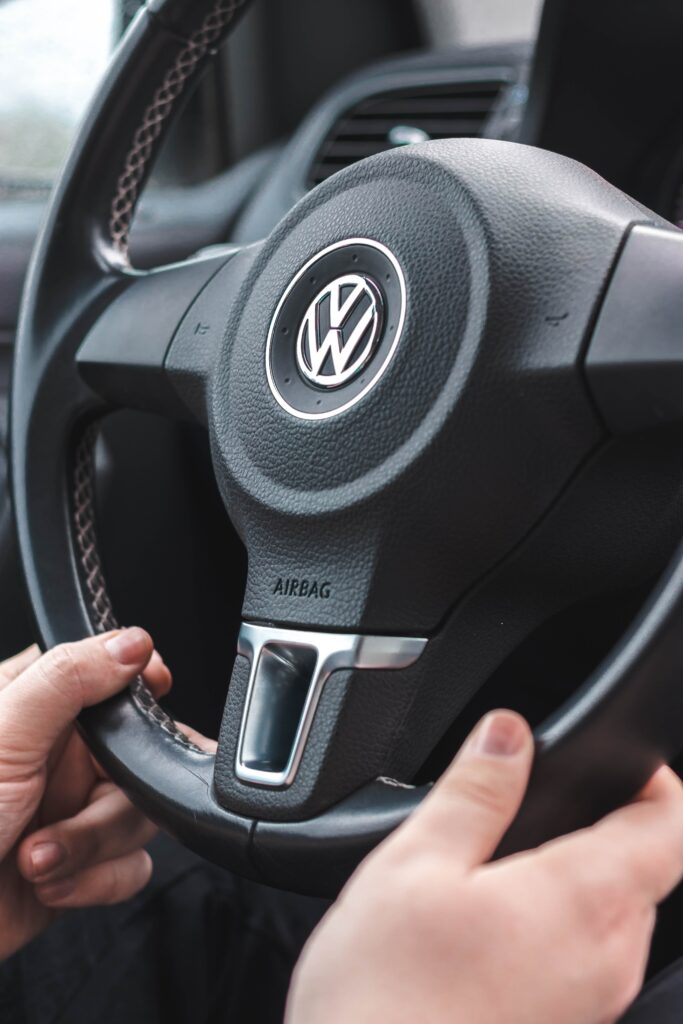In the fast-paced world of automotive safety, one essential component often overlooked is the steering wheel itself. While airbags have become a standard feature in modern vehicles, have you ever considered whether your steering wheel needs its own airbag? With the increasing advancements in vehicle technology and the need for enhanced safety measures, it’s time to take a closer look at this crucial aspect of our driving experience. So, let’s explore the question: does your steering wheel need an airbag?

What is an Airbag?
Definition of an airbag
An airbag is a safety device installed in vehicles, designed to protect occupants during collisions by rapidly inflating and cushioning the impact. It is a supplementary restraint system that works in conjunction with seat belts to enhance occupant safety.
How does an airbag work?
When a vehicle experiences a collision, sensors located throughout the vehicle detect the collision and send signals to the airbag control unit. The control unit, upon receiving the signals, activates the airbag inflation system. This system consists of an igniter, a propellant, and a bag module. The igniter creates a spark, which ignites the propellant, leading to a chemical reaction that produces a large volume of gas. The gas fills the airbag, causing it to rapidly inflate and deploy in front of the occupants, thereby serving as a cushion during impact.
Types of airbags
There are various types of airbags used in vehicles to cater to different types of collisions and impacts. The most common type is the frontal airbag, which is typically located in the steering wheel for the driver and in the dashboard for the front passenger. Side airbags, on the other hand, are installed on the sides of the vehicle to protect occupants during side-impact collisions. Additionally, there are also knee airbags, which are designed to protect the knees and lower body region, and curtain airbags, which deploy from the roof to provide head protection during a rollover or side-impact collision.
Importance of Airbags
Role of airbags in vehicle safety
Airbags play a crucial role in vehicle safety by reducing the impact of collisions on the occupants. They supplement the protection provided by seat belts and help prevent or minimize injuries to vital body parts, such as the head, chest, and abdomen. By rapidly inflating and providing a cushioning effect, airbags can significantly reduce the risk of serious injuries or fatalities in accidents.
Statistics on airbag effectiveness
Numerous studies and crash tests have demonstrated the effectiveness of airbags in reducing the severity of injuries. According to the National Highway Traffic Safety Administration (NHTSA), frontal airbags alone have been estimated to reduce driver fatalities in frontal crashes by about 29% and front-seat passenger fatalities by approximately 32%. These statistics highlight the life-saving potential of airbags in enhancing occupant safety.
Mandatory airbag regulations
Recognizing the significance of airbags in protecting vehicle occupants, many countries have implemented mandatory regulations regarding their installation in vehicles. For example, in the United States, the NHTSA has mandated the installation of frontal airbags in all passenger cars since 1998, further ensuring the safety of drivers and passengers. These regulations underscore the importance of airbags as an essential safety feature in modern vehicles.
Components of a Steering Wheel
Design and structure of a steering wheel
A steering wheel is a critical component of a vehicle’s control system, allowing the driver to maneuver and navigate the vehicle. It consists of a circular frame, usually made of a strong and durable material, such as steel or aluminum, and is designed to be ergonomic and comfortable for the driver’s hands. The outer rim of the steering wheel provides a grip surface, while the central part houses various features like control buttons, horn, and airbag module.
Material used for steering wheels
The materials used for manufacturing steering wheels have evolved over the years to ensure durability, comfort, and safety. Initially, steering wheels were mostly made of wood, which was later replaced by hard rubber and then steel. However, modern steering wheels are commonly made of high-quality synthetic materials, such as polyurethane or leather-wrapped thermoplastic, which offer a combination of strength, durability, and aesthetic appeal.
Functionality of a steering wheel
In addition to its primary function of allowing the driver to turn and control the vehicle’s direction, the steering wheel serves as a hub for various functions and controls. It houses controls for the vehicle’s audio system, cruise control, voice command, and phone connectivity. Additionally, modern steering wheels also incorporate paddle shifters for manual shifting in vehicles with automatic transmissions, further enhancing the overall driving experience.
Evolution of Steering Wheels
Early steering wheel designs
The concept of a steering wheel dates back to the early days of automobiles, where vehicles were initially equipped with tillers or levers for steering. However, these mechanisms were deemed inadequate as vehicles became faster and heavier, leading to the introduction of the steering wheel. The early steering wheels were generally large and made of wood or steel, offering limited maneuverability and often requiring significant effort to turn the wheels.
Introduction of collapsible steering columns
As safety concerns grew, automotive engineers began focusing on developing safer steering systems. One of the significant advancements in steering wheel technology was the introduction of collapsible steering columns. These columns were designed to collapse upon impact, reducing the risk of injury to the driver by preventing the steering column from penetrating the driver’s compartment.
Advancements in steering wheel technology
With the rapid advancement of technology, steering wheel designs have become more sophisticated and integrated with various features. For instance, modern steering wheels often include electronic controls, such as touchscreens and capacitive sensors, allowing drivers to control multimedia, navigation systems, and vehicle settings conveniently. Additionally, advanced driver assistance systems (ADAS), like adaptive cruise control and lane-keeping assist, are also integrated into steering wheels to enhance safety and provide a more efficient driving experience.

Potential Dangers While Driving
Common accidents and collisions
Despite numerous safety measures, accidents and collisions can still occur on the road. Common types of accidents include rear-end collisions, side-impact collisions, and rollovers, all of which pose potential dangers to drivers and passengers. These accidents can lead to severe injuries, including those caused by the impact with the steering wheel.
Injuries caused by steering wheel impact
In accidents where the driver’s upper body is propelled forward, the steering wheel can become a significant source of impact. The force of the impact, combined with the rigid structure of the steering wheel, can result in injuries, such as broken bones, internal injuries, and head or facial trauma. These injuries highlight the importance of implementing safety features that minimize the impact of steering wheel contact during accidents.
Importance of steering wheel safety features
To counter the potential dangers associated with steering wheel impact, automakers have incorporated various safety features into steering wheel designs. One key safety feature is the presence of an airbag within the steering wheel. By deploying in the event of a collision, steering wheel airbags help reduce the severity of injuries by cushioning the driver’s upper body and reducing the impact force exerted on vital body areas.
The Purpose of Steering Wheel Airbags
Types of airbags used in steering wheels
Steering wheel airbags come in different variations to cater to the specific safety needs of drivers. The most common type is the driver-side airbag, which deploys from the steering wheel to provide direct protection to the driver’s upper body and head during a collision. Additionally, some vehicles also incorporate a passenger-side airbag, which deploys from the dashboard to protect the front-seat passenger in the event of a crash.
Benefits of steering wheel airbags
Steering wheel airbags offer several benefits in terms of occupant safety. Firstly, they provide an additional layer of protection to the driver’s upper body, reducing the risk of severe injuries upon impact. Secondly, the deployment of the airbag helps prevent the driver from striking the steering wheel directly, minimizing the possibility of head or facial trauma. Lastly, steering wheel airbags work in conjunction with seat belts to create a comprehensive safety system that maximizes the chances of survival and minimizes the severity of injuries during accidents.
Effectiveness of steering wheel airbags
Numerous studies and real-world crash data have shown that steering wheel airbags significantly reduce the risk of severe injuries and fatalities. According to research conducted by the Insurance Institute for Highway Safety (IIHS), frontal airbags, including steering wheel airbags, are estimated to reduce the risk of driver fatalities in frontal crashes by approximately 29%. This demonstrates the effectiveness of steering wheel airbags as life-saving safety features.

Industry Standards and Regulations
National Highway Traffic Safety Administration (NHTSA) regulations
The NHTSA, as part of its commitment to ensuring vehicle safety, has implemented comprehensive regulations regarding airbags and steering wheel safety. These regulations lay down specific requirements and standards for manufacturers to comply with when designing and manufacturing airbags and related systems. By adhering to these regulations, automakers can guarantee that their vehicles meet the necessary safety standards and provide adequate protection to occupants.
European New Car Assessment Programme (Euro NCAP) standards
In Europe, the Euro NCAP has established safety standards and rating systems to evaluate the safety performance of vehicles. The program assesses vehicles based on numerous criteria, including occupant protection, adult and child safety, and safety assist features. These standards play a crucial role in driving innovation and encouraging automakers to continuously improve the safety of their vehicles, including steering wheel airbags.
Safety advancements in steering wheel airbags
Over the years, significant advancements have been made in the design and technology of steering wheel airbags to enhance their effectiveness and safety. Improvements include the development of dual-stage airbags, which allow for different levels of inflation based on the severity of the crash, and advanced airbag control units that can analyze various sensor inputs to determine whether airbag deployment is necessary. These advancements have further increased the safety provided by steering wheel airbags, ensuring optimal protection for drivers and passengers.
Airbag Deployment and Maintenance
Factors triggering airbag deployment
Airbags are designed to deploy in specific scenarios where the risk of injury is high. These scenarios typically involve a significant deceleration or rapid change in vehicle speed due to a collision. The deployment of airbags is triggered by sensors located throughout the vehicle, which detect the impact and send signals to the airbag control unit. The control unit then initiates the deployment process, inflating the airbags within milliseconds to protect the occupants.
Proper maintenance and inspection of airbags
To ensure the reliable performance of airbags, regular maintenance and inspection are crucial. Vehicle owners should follow the manufacturer’s guidelines regarding airbag maintenance, which typically include periodic inspections by qualified technicians. It is essential to keep the area around the airbag clear of objects that may obstruct deployment, such as stickers, sunshades, or other aftermarket accessories. Additionally, any fault codes or warning lights related to the airbag system should be addressed immediately.
Common issues and troubleshooting
Despite their effectiveness, airbags can sometimes experience issues that may affect their functionality. Common airbag-related problems include faulty sensors, damaged wiring, or control unit malfunctions. If a warning light related to the airbag system illuminates on the vehicle’s dashboard, it is recommended to have the vehicle inspected by a professional technician. They can diagnose the issue and perform any necessary repairs or replacements to ensure the airbags are in optimal working condition.

Steering Wheel Airbags: Pros and Cons
Advantages of steering wheel airbags
Steering wheel airbags bring significant advantages to vehicle safety. First and foremost, they provide a vital layer of protection to the driver’s upper body, particularly the head and chest, reducing the risk of severe injuries during frontal collisions. The rapid deployment of the airbag helps cushion the impact and prevents the driver from striking the steering wheel directly. Additionally, steering wheel airbags work in conjunction with seat belts, creating a comprehensive safety system that increases the chances of survival and reduces the severity of injuries.
Limitations and drawbacks of airbags
While steering wheel airbags have proven effective in enhancing occupant safety, they do have some limitations and potential drawbacks. One limitation is their inability to protect against injuries resulting from side-impact or rollover collisions. In these types of accidents, additional airbags, such as side or curtain airbags, play a more significant role in mitigating injuries. Moreover, in rare cases, airbags can deploy with excessive force, causing injuries or unintended harm. This is why proper installation, maintenance, and inspection of airbags are crucial.
Alternative safety measures
While steering wheel airbags are an essential safety feature, they are not the sole solution to occupant protection. Other safety measures, such as seat belts, crumple zones, and advanced driver assistance systems (ADAS), like automatic emergency braking and lane-departure warnings, all play a crucial role in ensuring overall vehicle safety. It is the combination of these various safety features that collectively enhance the safety of both the vehicle’s occupants and other road users.
Future Innovations in Steering Wheels
Integration of smart technology into steering wheels
As technology continues to advance, steering wheels are evolving to incorporate smart features that enhance convenience and safety. For example, some steering wheels now integrate touch-sensitive panels or capacitive sensors, allowing drivers to control multimedia systems, navigate menus, or communicate with voice commands without taking their hands off the wheel. This integration of smart technology into steering wheels streamlines the driving experience while minimizing distractions.
Advanced sensors and collision avoidance systems
Steering wheel airbags are likely to benefit from advancements in sensor technology and collision avoidance systems. Sensor technology, such as radar, lidar, and cameras, will become more sophisticated, enabling faster and more accurate detection of potential collisions. This enhanced detection capability will enable airbag systems to deploy with even greater precision and timing, optimizing protection for vehicle occupants.
Potential impact on steering wheel airbags
As the automotive industry moves towards autonomous vehicles and electric cars, the role of the steering wheel itself may change. With self-driving technology, the need for manual steering may diminish, leading to steering wheels becoming more compact or even replaced by alternative control interfaces. However, regardless of the evolution of steering systems, the importance of occupant safety and the role of steering wheel airbags as a vital safety feature are likely to remain unchanged.
In conclusion, steering wheel airbags are a crucial component of modern vehicle safety systems. They significantly reduce the risk of severe injuries during collisions by cushioning the impact and preventing direct contact between the driver and the steering wheel. With advancements in technology and ongoing research, steering wheel airbags are becoming even more effective and reliable in protecting occupants. However, it is important to remember that airbags alone are not the sole solution to vehicle safety and that a holistic approach should be taken, combining various safety features to ensure maximum protection for all vehicle occupants.


